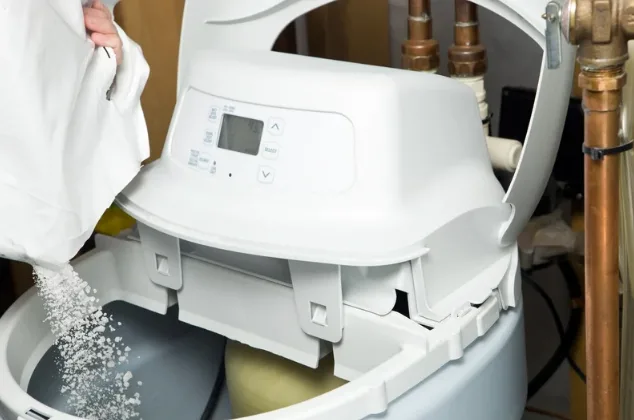Homeowners must pick the most suitable water softener to handle their hard water issues. Salt-based and salt-free water treatment methods manage mineral accumulation differently, offering various performance benefits, maintenance requirements, and health impacts. Here are factors to consider to help you decide which option aligns with your priorities.
Learn the Facts About Water Softeners
Performance: Hard Water Removal vs. Conditioning
A water softener using a salt-based system excels by removing hard minerals like calcium and magnesium. It achieves this through the ion exchange process. As water passes through a resin bed, hardness ions are replaced with sodium ions, reducing mineral content.
This technology generates completely soft water that blocks scale formation and safeguards appliances while making soap more efficient. These systems are ideal for areas with heavy hard water (over 75 grains per gallon) as they address mineral problems at their source.
In a salt-free water softener, the Template Assisted Crystallization (TAC) process transforms minerals into harmless crystals that resist surface adhesion. While this prevents new scale formation, it doesn’t remove existing minerals, leaving water technically hard. Best suited for mild to moderate hardness (below 75 grains per gallon), it appeals to households prioritizing mineral retention for taste or health reasons. However, in areas with extreme hardness, effectiveness may be limited compared to salt-based systems.
Maintenance and Environmental Trade-Offs
A salt-based water softener requires regular upkeep, including refilling salt every six to eight weeks and cleaning resin tanks to prevent clogs. These systems also produce brine wastewater during regeneration cycles, which can harm ecosystems if improperly managed.
For environmentally conscious users, this raises concerns about soil degradation and freshwater contamination. High maintenance costs and frequent regeneration cycles make them less appealing in regions with strict environmental regulations.
In contrast, a salt-free water softener is low-maintenance, requiring only annual filter replacements and occasional media checks. Without brine discharge or regeneration cycles, it reduces water waste and environmental impact significantly. Its “set and forget” nature appeals to eco-friendly homeowners. However, since it doesn’t address existing scale, it’s less effective in homes with legacy plumbing issues caused by untreated hard water over time.
Health Considerations and Installation Complexity
Health plays a pivotal role in choosing a water softener. A salt-based system adds trace sodium to water (about 7.5 to 12.5 mg per glass), which may concern individuals on low-sodium diets. Alternatives like potassium chloride pellets exist but come at a higher cost.
To mitigate health risks, softened water can be bypassed for drinking and cooking. A salt-free water softener retains beneficial minerals like calcium and magnesium, making it ideal for households valuing mineral-rich water for taste and nutritional benefits.
The complexity of a water softener system installation also varies. Salt-based units often require professional setup due to plumbing modifications and electrical connections for regeneration cycles. Improper DIY installation risks leaks or voided warranties. A salt-free water softener, compact and free of brine tanks, is easier to install independently, saving upfront costs. Its simpler design aligns well with streamlined installation processes, offering added convenience.
Cost Considerations
Budget plays a key role in determining which water softener is the right choice. Salt-based models tend to have higher upfront costs due to the need for additional components like a brine tank and resin bed. Installation fees can add to the initial expense, especially if professional help is required.
A salt-free water softener often comes with a lower initial investment, as it does not require complex plumbing modifications. Additionally, since it has minimal maintenance costs over time, it provides better long-term savings for homeowners looking for an economical solution.
Impact on Appliances and Plumbing
Using a water softener helps extend the lifespan of household appliances by preventing mineral buildup. A salt-based system eliminates hardness minerals, ensuring pipes, water heaters, and dishwashers function efficiently. The absence of scale improves energy efficiency, leading to lower utility bills.
A salt-free water softener, while preventing new scale formation, does not remove existing deposits. This means homes with pre-existing plumbing issues may still experience reduced water flow and inefficiencies in older appliances. Households with severe mineral buildup might benefit more from a salt-based system.
Endnote
Choosing between a salt-free or salt-based water softener depends on balancing performance, maintenance, and health priorities. A salt-based system delivers superior results by removing hard minerals entirely, making it ideal for severe hardness levels. However, it demands regular upkeep and poses environmental challenges.
A salt-free water softener conditions water to prevent scale without removing minerals, offering a sustainable, low-maintenance alternative better suited for mild hardness. Ultimately, the best choice hinges on your specific needs, budget, and values. By carefully evaluating these factors, you can select a system that ensures optimal water quality tailored to your lifestyle.






